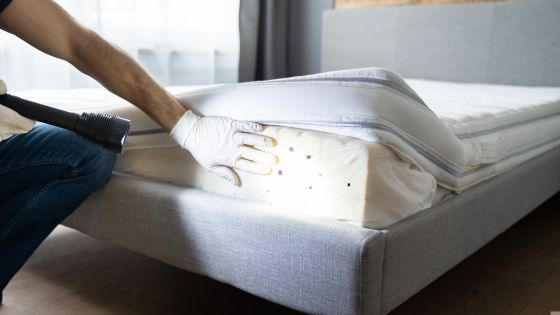Bed bugs are an unwelcome nuisance in any home, and they can be notoriously difficult to detect in the early stages. If left untreated, these tiny pests can rapidly infest your property, making it important to be aware of the signs of a bed bug problem. Bed bugs feed on human blood, and their bites can cause significant discomfort, irritation, and even sleep disturbances.
In this article, we will explore the five common signs of a bed bug infestation. By learning how to identify these signs early, you can take action quickly and seek professional Bed Bug Pest Control services to eliminate these pests before they spread.


Unexplained Bites On Your Skin
One of the first signs of a bed bug infestation is the appearance of unexplained bites on your skin. Bed bugs tend to bite exposed skin, such as the arms, legs, or neck, during the night while you sleep. These bites are typically red, itchy, and inflamed. Often, they appear in a line or cluster, as bed bugs tend to feed in a series of small bites.
Understanding Bed Bug Bites
Bed bugs are nocturnal creatures, and they come out at night to feed on your blood. They are attracted to the carbon dioxide you exhale as you sleep. Bed bug bites typically occur when the bugs pierce the skin with their needle-like mouthparts to feed. After feeding, they retreat into their hiding spots, leaving you with itchy, red marks. These bites can cause varying degrees of irritation, depending on your skin’s sensitivity and the extent of the infestation.
Although the bites themselves are not necessarily dangerous, they can cause discomfort and may lead to infections if scratched excessively. In some cases, individuals with allergies to bed bug saliva may experience more severe reactions, including swelling and blisters.
How To Identify Bed Bug Bites
Bed bug bites are typically easy to identify due to their specific characteristics. The bites are small, red bumps that often appear in a line or cluster. In some cases, you may also notice a mild swelling around the bite site. The bites may take a few days to develop fully, and the area will often become itchy, leading to the urge to scratch. Bed bugs usually target exposed areas of the body, such as the arms, legs, and neck.
What To Do If You Find Bed Bug Bites
If you notice multiple bites that seem to appear overnight, it’s essential to check for other signs of a bed bug infestation. Look for blood stains, droppings, or the bugs themselves. If you suspect a bed bug problem, it’s a good idea to contact a Pest Control Sydney expert who can inspect your property and recommend the best treatment plan.
2. Bed Bug Droppings Around Your Property
Another key indicator of a bed bug infestation is the presence of small, dark droppings around your property. Bed bug droppings are the result of digested blood and can often be found on your bedding, mattresses, or even on nearby furniture. These droppings look like tiny black or dark brown spots that resemble pepper flakes. Over time, as the infestation grows, the droppings will become more abundant, and they will be easier to spot.
What Do Bed Bug Droppings Look Like?
Bed bug droppings are small, dark spots that appear on sheets, mattresses, walls, and furniture. They are the result of bed bugs feeding on blood and then excreting the waste material. These dark, ink-like stains are often seen around the seams of your mattress, along the edges of furniture, or near cracks and crevices in the walls. They can also accumulate in areas where bed bugs like to hide, such as behind baseboards or inside furniture.
How To Spot Bed Bug Droppings
Bed bug droppings are relatively easy to spot once you know what to look for. Look closely at your sheets, mattress seams, and furniture for small, dark stains that resemble ink spots or pepper flakes. These droppings are usually small, no larger than the size of a pinhead, and can often be mistaken for dust or dirt. However, if you notice an accumulation of these spots in a concentrated area, it’s a clear sign that bed bugs are present.
What To Do If You Find Bed Bug Droppings
If you find droppings in your home, it’s important to take action immediately. Contact a Pest Control Sydney specialist who can inspect your property for other signs of bed bugs. Professional pest control services can help you identify the extent of the infestation and implement the right treatment to eliminate the pests.
3. Blood Stains On Sheets and Pillowcases
Blood stains on your sheets or pillowcases are another clear indication of a bed bug infestation. Bed bugs feed on blood by piercing the skin with their needle-like mouthparts. After feeding, they often leave behind small blood stains on your sheets, pillowcases, and other bedding.
What Causes Blood Stains?
When bed bugs feed, they can sometimes be crushed accidentally during sleep or move around on your bed. This can cause them to leave behind small blood stains on your sheets or pillowcases. The blood stains can range from small dots to larger smears, depending on the severity of the infestation and how frequently the bed bugs are feeding.
How To Detect Blood Stains
Blood stains from bed bugs are typically red or brown and can appear as small dots or smears. These stains may be concentrated around the areas where you sleep, such as your pillow or mattress. Over time, if the infestation is not addressed, these blood stains can become more frequent and noticeable.
What To Do If You Find Blood Stains
If you discover blood stains on your sheets or pillowcases, it’s a sign that bed bugs may be feeding on you while you sleep. It’s important to act quickly and contact a Pest Control Sydney professional to investigate the situation and determine the extent of the infestation. Prompt action can prevent the problem from worsening and help ensure that your home remains safe and free of bed bugs.
4. Musty Odour in Your Home
A musty, sweet smell in your home can also indicate the presence of a bed bug infestation. Bed bugs release a distinctive odour from glands located near their abdomen. This smell is often described as being sweet or musty and can become more pronounced as the infestation grows.
Why Do Bed Bugs Release An Odour?
Bed bugs use their scent glands to communicate with one another, marking territory and signalling the presence of food. The scent is often stronger in areas where bed bugs congregate, such as behind headboards, in furniture seams, or along the edges of mattresses. The musty or sweet odour may not be immediately noticeable in the early stages of an infestation, but it becomes more apparent as the infestation grows.
How To Detect The Musty Smell
If you notice a musty or sweet smell in your home, especially near your bed or furniture, it may be a sign of a bed bug infestation. The odour is most noticeable in confined spaces where bed bugs are likely hiding. As the infestation worsens, the smell will become stronger and more unpleasant. This is an important sign to watch out for, as the presence of a bed bug odour suggests that the pests are thriving and multiplying.
What To Do If You Detect A Musty Odour
If you notice a musty or sweet smell in your home, it’s essential to investigate the source. Check your mattress, bed frame, and surrounding areas for other signs of bed bugs. If you cannot locate the source of the smell, it’s time to contact a Pest Control Sydney expert who can inspect your property for signs of infestation and provide effective treatment.
5. Live Bed Bugs or Eggs Found in Your Home
The most definitive sign of a bed bug infestation is the discovery of live bed bugs or their eggs. Adult bed bugs are small, oval-shaped insects that are reddish-brown and about the size of an apple seed. Bed bug eggs are even smaller and appear as tiny, white dots. They are typically found in cracks and crevices, along mattress seams, or in the corners of furniture.
How To Spot Live Bed Bugs or Eggs
Adult bed bugs are typically about 4-5mm long and can be seen with the naked eye. They are reddish-brown and are often mistaken for other pests, such as cockroaches or carpet beetles. Bed bug eggs are even smaller, approximately 1mm in size, and are white or translucent. They are usually laid in hidden areas, such as behind baseboards, inside furniture seams, or under the edges of carpets.
What To Do If You Find Live Bed Bugs or Eggs
If you find live bed bugs or their eggs in your home, it’s essential to seek Bed Bug Pest Control immediately. Bed bugs can multiply quickly, and it is difficult to eliminate them without professional help. A pest control expert will have the tools and experience to properly assess the situation and provide an effective treatment plan to eliminate the infestation.
Frequently Asked Questions (FAQS)
1. Can I get rid of bed bugs myself?
While some DIY methods may be effective in killing a few bed bugs, it is difficult to eliminate an infestation without professional help. Bed bugs are highly resilient and can hide in tiny cracks and crevices, making it hard to address the problem on your own. Contacting a Pest Control Sydney specialist is the best way to ensure that your property is fully treated.
2. How long does it take to get rid of bed bugs?
The duration of bed bug treatment depends on the severity of the infestation. In most cases, it may take several weeks to eliminate bed bugs, as the pests may be hiding in hard-to-reach areas. A professional Bed Bug Pest Control service will likely require multiple visits to ensure that all bed bugs are eradicated.
3. Are bed bugs dangerous?
Bed bugs are not known to transmit diseases, but their bites can cause significant discomfort, itching, and allergic reactions in some individuals. In severe cases, scratching the bites can lead to secondary infections. If left untreated, a bed bug infestation can cause emotional distress due to sleep deprivation.
4. How do bed bugs spread?
Bed bugs are highly mobile and can be transported in luggage, clothing, or second-hand furniture. They are most commonly introduced to a home after travel or from infested public spaces such as hotels, theatres, or public transport. Once they find a suitable place to hide, they will begin to multiply quickly.
5. Can I prevent a bed bug infestation?
Preventing a bed bug infestation requires vigilance. Avoid purchasing used furniture or mattresses without inspecting them thoroughly for signs of bed bugs. When travelling, check your hotel room for signs of bed bugs, and keep your luggage elevated off the floor. Regular inspections and prompt Pest Control service in Sydney can help prevent an infestation.
Conclusion
Identifying a bed bug infestation early is crucial to preventing a larger problem. If you notice any of the signs mentioned above, it’s important to take action quickly and seek professional help. Bed bug problems can worsen over time, so don’t hesitate to contact a Pest Control Sydney expert for assistance. With the right treatment, you can eliminate these pests and protect your home from further infestations.
























